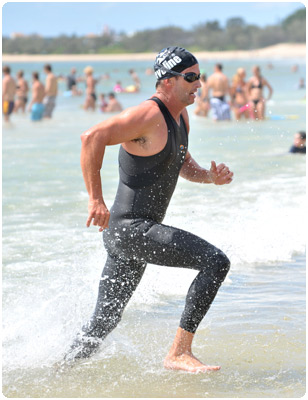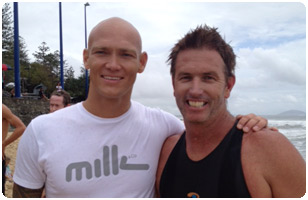 |
|
On the Starting Line If it is a beach start, focus on wading into the water. The major differences between wading and running: Wading- the leg action is high and to the side, and there is great emphasis on stomach muscles. Legs must be elevated high, yet to the side, to enable you to jump over waves (up to a certain height). The side action is similar to that of a hurdler. A dolphin dive is a shallow dive where you push forward off the ground with your legs and dive just under the surface of the water. Do not look up when dolphin diving. This is for safety as well as speed. Push off from the bottom each time you propel yourself forward. When the race begins, get in the slip stream of that swimmer straight away. Don’t be aggressive. Think positive and all the hard work, early starts and gym sessions you’ve done.
If someone hits you or is annoying, you don't hit or annoy them back - just swim away from them. If you get angry with them, it will take your focus and energy from your race. Don't even try and look at who it is, as it will only make you even angrier. Just swim away from them and pretend it never happened. Conserve your energy. If you're leading the pack, lift your head approx every 6 strokes just to make sure you're keeping a straight line.
Do not lift your head when turning a buoy (unless you want it knocked off). 15 - 20 metres before a turning buoy, pick up the pace. You want to have fast momentum when turning a buoy.
Work a 6 beat kick Focus on exiting the water. Coming into shore – when your hands touch the bottom of the shore, stand up and start wading out to the finish line.
Only worry about things you can control... you can't control your competitors – you can’t control tidal conditions and the weather - so don't worry about them. In open water swimming the fastest doesn't always win or come out of the water first, the smartest does. |
|



